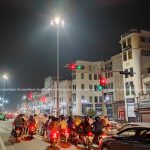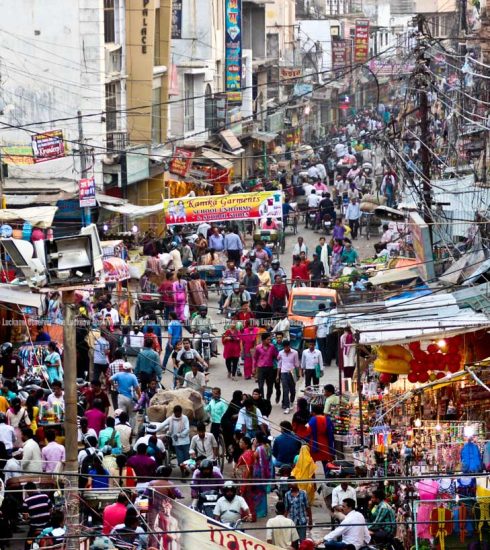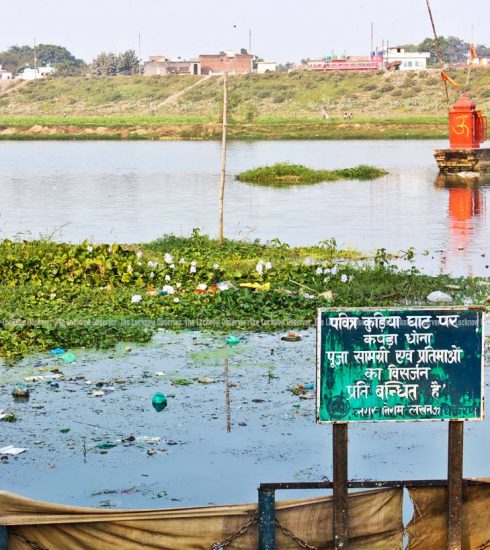Ganjing !
Exploring the shopping, food and much more…!
Lucknow with all its tehzeeb and ada is noted for one more thing. Any guesses? Think of the Bullet Raja, a movie based on Uttar Pradesh mafia and it will remind you of the beautifully clothed Hazratganj in the Victorian attire. Today Ganj is a perfect place for dining, shopping and of course “ganjing.”
Nothing can beat Hazratganj when it comes to food. Today the area boasts of choicest food outlets like Marksmen, Aryans, Rovers, Moti Mahal… the list is endless. “Ganjing with food” concept came in vogue in 1930’s by the Royal Café, which was situated in the Halwasiya court complex and offered a whole range of services ranging from candlelit dinners, dancing and music. It was shifted near Capoor’s Hotel in 1960s. Today the place is well-renowned for Indian snacks like panipuri and aaloo ki tikki. But basket chaat tops the list of its menu. The once-famous Kwality restaurant opened in 1949. Located next to Mayfair it had a seating capacity of 100 at the ground floor and 60 on the first floor. The mobile food joints also came into picture, only to be relegated to the background after crackdown on hawkers in 1948. The Prince of Wales Hall had a Prince shopping complex along with Krishna Restaurant and Indian Coffee House. Another two well-known restaurants were Annapurna (now Wajid Husain furniture shop) and Ranjana catering to elite diners with a pocket–friendly menu. Benbows (now Chhangamal Rohia) was a Swiss confectionery shop run by Sardarji. For authentic Chinese cuisine, one could go to Simson situated in the Capitol building and Hong Kong, both of whom no longer exist. Joe Hing, also housing a beauty parlor is the only survivor of the trio. Owned by a former cobbler, the place now wears a deserted look being outclassed by newer outlets. The now defunct China Bar and Restaurant (existing where Flying Machine retail outlet is situated) catered to the middle class people. Any discussion of Hazratganj is incomplete without mentioning India Coffee House situated at the crossroads of Vidhan Sabha Marg and Ashok Marg, it had been a rendezvous for journalists, intellectuals, academicians and the like. Several literary journals, socio political movements and cultural awakenings were born over cups of coffee. It was visited by likes of Jawaharlal Nehru, Dr. Ram Manohar Lohia, Acharya Narendra Dev, Feroze Gandhi and Bhagwati Charan Varma and last but not the least by former US Ambassador to India, Henry Barnes. Though the crowd at the Coffee House has rapidly dwindled, its coffee continues to be relished by the older generation of coffee lovers. Gradually new food outlets sprang up in Ganj and continue to garner popularity due to variety of dishes served by them. Prominent among them is Rovers, situated opposite to the GPO, it is frequented by students of nearby colleges. Its food quality may have gone down in recent years nevertheless it enjoys popularity due to its reasonable rates. Moti Mahal is a perfect bet when it comes to vegetarian family dinners. Thriving on the concept of self service, the dal makhani served by Aryans is a must try. For dosa lovers, Marksmen is the perfect place to be. The restaurants of the Capoor’s Hostel provide a complete package of Awadhi cuisine, soothing music and appealing ambience. And how can one forget lip smacking non-vegetarian food outlets in the City of Nawabs! Naushijaan, situated next to Tulsi, is a paradise for non- vegetarian food. Though ambience here is not very appealing, the kebabs especially Galawati Kebab and Kakori Kebab leave you craving for more. Another place worth visiting is the Mughal’s Dastarkhwan. The biryani and roasted chicken served by it, just melts in your mouth. Those with sweet tooth must visit Ram Asrey, one of the oldest sweet shops in Lucknow, renowned for its Nawabi malai paan, the shop serves a wide range of finest of desserts.
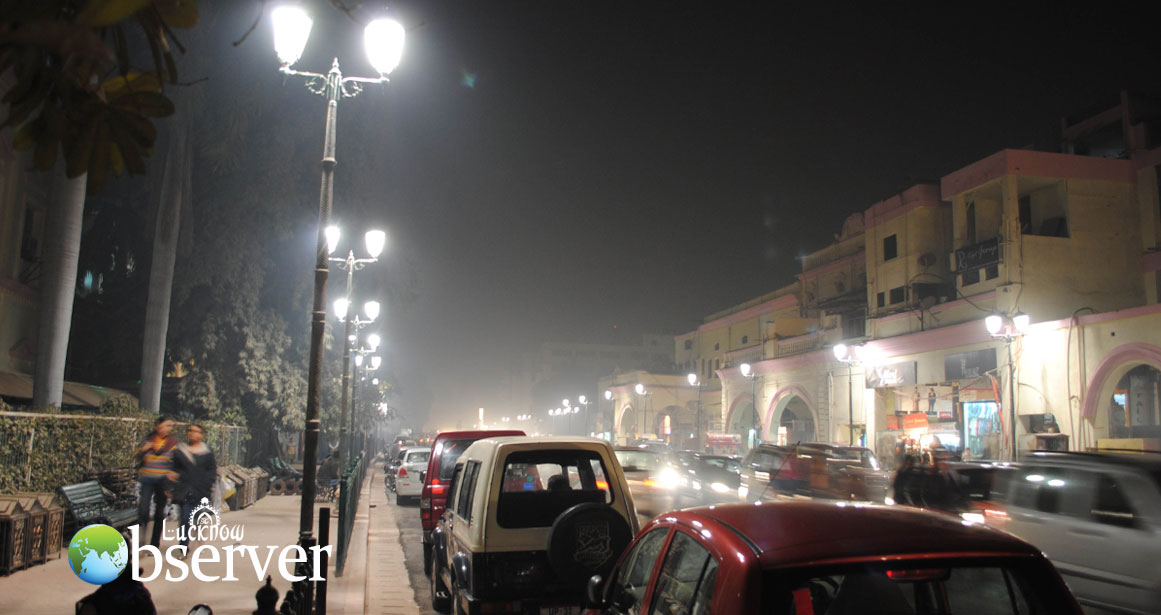
When it comes to snacks, nothing can beat over a century old, Chedi Lal Ram Prasad Vaish food outlet. Serving scrumptious ice creams to choicest shakes, the place is overcrowded especially in the evenings. Though its plastered walls lack aesthetic appeal, the owner tells us to gear up to be served in its new avatar soon. Think of pao-bhaji and Bombay food outlet comes to your mind. From a small stall, it has grown into a shop with enhanced rates of dishes, but pao- bhaji served here is inarguably the world’s best. For tasting authentic kachauris, do visit Bajpai Poori Bhandar once. Among coffee chains, CCD continue ruling the roost. Rates here may be exorbitant but the variety of coffee here is endless. Ram Kewal’s bakery products are well known. Hazratganj has a tasty street food too especially masala shikanji, Awadhi paan and chaat.
Despite the establishment of various malls in the city, Hazratganj has maintained its popularity of a shopping hub. Being a centre of various markets like Prince Market (in the ground floor of Sahu cinema building, where you can get jeans at a throwaway price), Halwasiya market and Janpath, the bazaars here have a timeless appeal. Though the then Nawab Nasiruddin Haider laid the foundation of the Kaptan Bazaar, which sold imported stuff from China and Belgium, as early as 1827, Hazratganj had a reputation of being primarily a wholesale grain market till 1909.
There was also China Bazaar having a range of shops of same height arranged along its length with piazzas along their whole front. Later most of its markets were demolished during the colonial rule. Perhaps the most famous shopping centre, Khaas Bazaar survived till 1858. The commercial wave also forced several shops to close their shutters. Prominent among them being A. N. James and Co, a famous drug pharmacy, Murray and Co, the general Merchants of quality goods, G.W. Lawrie and Co. Photographers, Gentleman Tailors and outfitters, now ‘Woodland’ showroom. The famous Janpath market came up in 1977 after the British demolished Begum Kothi (built and gifted by Amjad Ali Shah to his wife Queen Malka Ahad). As you enter the area, a fountain with a small garden maintained by the Janpath Traders Association welcomes you. Today Janpath is widely adored by youngsters for its latest apparel collection and in vogue junk jewellery.
Among all arts, Lakhnavi chikankari has caught the fancy of world renowed designers. Ada has been portraying chikan as a global brand since 2003. Ada as the name symbolizes stands for Lakhnavi etiquette. “To put a conservative estimate, chikan has 32 various forms of embroidery. Its significance lies in the fact that it cannot be replicated anywhere. The art probably originated in Afghanistan and was brought to India by Nurjahan,” says Mr. Haider Ali Khan, the owner, who has been associated with chikankari for almost 20 years. So what kind of clientele does Ada cater to and what is its uniqueness? “We cater to elite people, not elite monetarily but elite in taste. We have done chikan work on all sorts of fabrics ranging from cotton to pashmina. Recently we started it on kanjivaram saris representing a jugalbandi of North and South Indian tradition”, Mr. Ali says. Another shop which continues to have timeless appeal is the Gandhi Ashram. Erected on the ruins of the Valerio restaurant, the shop is well known for khadi made by weavers in remote India. As I ask for visiting card in the shop, I get a prompt reply “Yahan koi visiting card nahi hota”, reminding me of the Indianness of the place. We Indians are more informal in our dealings. Though the shop is deserted when i visited, I noticed a copy of 150 invoices of the day indicating its continuing popularity among khadi lovers. Sharmaji, a floor staff is happy that the present State government besides the Central government is giving subsidy to the shop, which promotes them. He also tells us to wear khadi. “Main apse anurodh karta hoon ki aap log khadi pehne aur agar nahi ho sake to ek khadi ka rumaal zarur rakhe,” “Khadi vastra nahi vichaar hain”.
Saree shops adorn the main Hazratganj market, prominent among them being Sugnamal, Saree Bhawan, Modern Silk House and Calcutta in style. These shops cater to elite class and have a range of exquisite sarees and lehengas in stock. And they are socially responsible too. Saree Bhawan maintains a small beautified area in front of it. Sewa Chikan is trying to revive the past glory of Lakhnavi tehzeeb by installing hoardings near its entrance. The area is also a hub for gold and diamond jewellery showrooms, prominent among them being Lala Jugal Kishore Jewellers, PC Jewellers and Tanishq, a showroom for branded jewellery.
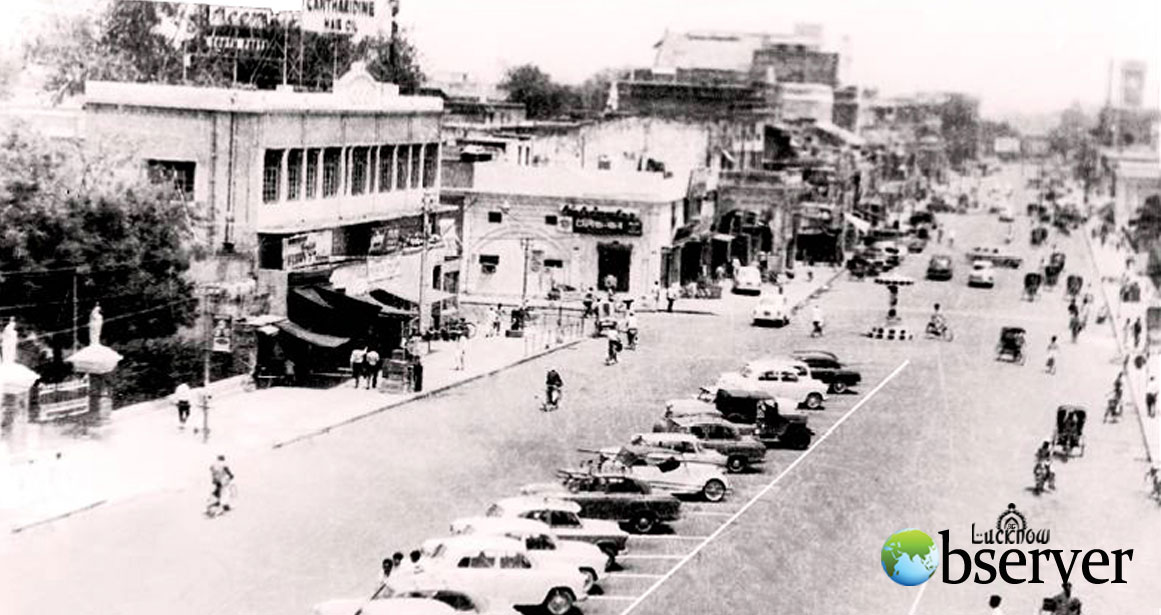
Hazratganj’s association with education started with the advent of Christian missionaries during the colonial era. Ram Advani Booksellsers and the British Book Depot are among the oldest book shops in the area. Opened in 1951 in the Mayfair Building, Ram Advani bookshop has successfully withstood the test of time. To this, an enthusiastic gentleman in 90s will greet you charmingly as you enter the shop. The British Book Depot was opened by Mr. Shanti Prakash Kakkar, who originally belonged to Lahore. “Our bookshop has been graced by likes of Pandit Nehru, Sonia Gandhi and her children. At that time we had imported stuff,” says Mrs. Uma Kakkar proudly, who owns the shop now. Though the shop does not stock all the latest books, some of the oldest classics can be found here. “We do not believe in modernizing, Old is gold,” Mrs. Kakkar says. Though she admits that popularity of books has declined, she is relieved that there is still a sizeable population, which still reads books in this Internet era. Universal Booksellers has emerged as perhaps most popular bookshops in Ganj. As you enter the shop, Mr. Manav Prakash, the owner, is busy dealing with customers. The shop has a wide collection ranging from classics to newly released books and latest stationery. The prompt customer service adds to its popularity. Selling books below market rates, bookstalls are a must visit for voracious readers. One of the bookstalls that has served generations since 1965 is the Dharma Pustak Bhandar. Over these years, it has moved from selling just religious books to all sorts of books under one roof. Bookstalls and poster shops line the CCD area and enjoy popularity due to their reasonable rates. Opposite DRM office is the Kalakunj, which offers gifts magazines and greeting cards. Representing the epitome of mall culture is the multi storeyed Saharaganj. Built on the land of Carlton hotel, which offers shopping, dining and cineplex under one roof.
Hazratganj is also a home to reputed schools of the city. The beginning was made by Emma Thompson Girls’ school which was established by the Christian Missionary Society. The Christ Church, commemorating the fallen soldiers in the 1857 rebellion was consecrated on November 26, 1860 by Bishop Cotton. Today it is also an intermediate college.
Another prominent school is the Cathedral which becomes lively during Christmas celebrations. The La Martinere Girls College was originally established as the Lucknow Girls School by Mrs. Abbott, housed in the Khurshid Manzil. Today it is one of the most prestigious educational institutions of the city. Keeping with the trend of thriving coaching centres, many of them have also mushroomed in the area. The Akaash institute, the biggest coaching centre for medical entrances is located right behind the Prince Shopping Complex. Huge crowd of students can be seen attending Trivaag and Kishore Tripathi coaching keeping alive the hope to crack coveted IIT entrance exam.
Many public offices have come up on the ruins of Nawabi structures. Prominent among them is Allahabad Bank, the oldest joint stock bank in the country. Erected on the ruins of townhouse, is the Central Bank of India. Nestled between Gandhi Ashram and Saree Bhawan is the Soochna Vibhag. Its library boasts of having a subscription of 21 newspapers and 53 magazines. “But it is largely inaccessible”, mourns a reader. Soochna Vibhagh library is the lone survivor in the area after the British Council Library was forced to close shutters despite protests by several academicians and literary people. The hotels of Hazratganj promise a pleasant stay for tourists. Located opposite Laxman Park, the hostel promises you a luxury stay with its air-conditioned rooms and state of the art facilities. Situated on the Mahatma Gandhi Marg, is Hotel Levana which is a preferred choice for business travelers with its aesthetically designed rooms and ultra modern facilities.
Hazratganj with all its unsurpassed grandeur and charm can be described in what Shakespeare had said of Cleopetra, “Age cannot wither her, nor custom stale her infinite variety.”
Continuously renovating the area without tampering with its cultural heritage is a need of the hour considering the fact that it is a reminder of the city’s glorious bygone era.
Ashita Kulshreshtha
Writer is a Freelance Journalist and a student of Journalism
(Published in The Lucknow Observer, Volume 1 Issue 9, Dated 05 December 2015)





